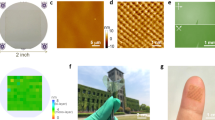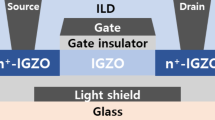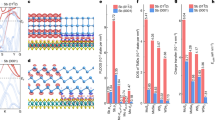Abstract
High-performance and low-power thin-film transistor technology is needed for the development of wearable electronics and the Internet of Things. However, the thermionic limit of the subthreshold swing sets an upper bound on the performance of such systems. Here we report a subthermionic organic thin-film tunnel transistor based on interfacial molecule decoupling. In these devices, minimized gap states at the interface between the metal oxide layer and the organic semiconductor lead to quantum band-to-band tunnelling injection at a small supply voltage. Our thin-film transistors exhibit a subthreshold swing of 24.2 ± 5.6 mV dec−1 and a signal amplification efficiency of 101.2 ± 28.3 S A−1. The average subthreshold swing is below 60 mV dec−1 for over four decades of current. We use the transistors to build amplification circuits that offer a gain of over 537 V V−1 at a low power of less than 0.8 nW, and create sensor interfaces that can measure electrophysiological signals with a high signal-to-noise ratio.
This is a preview of subscription content, access via your institution
Access options
Access Nature and 54 other Nature Portfolio journals
Get Nature+, our best-value online-access subscription
$32.99 / 30 days
cancel any time
Subscribe to this journal
Receive 12 digital issues and online access to articles
$119.00 per year
only $9.92 per issue
Buy this article
- Purchase on SpringerLink
- Instant access to full article PDF
Prices may be subject to local taxes which are calculated during checkout




Similar content being viewed by others
Data availability
The data that support the findings of this study are available from the corresponding authors upon reasonable request.
References
Zhong, D. L. et al. High-speed and large-scale intrinsically stretchable integrated circuits. Nature 627, 313–320 (2024).
Jiang, Y. W. et al. Topological supramolecular network enabled high-conductivity, stretchable organic bioelectronics. Science 375, 1411–1417 (2022).
Kim, J. et al. Monolithically integrated high-density vertical organic electrochemical transistor arrays and complementary circuits. Nat. Electron. 7, 234–243 (2024).
Wang, W. C. et al. Neuromorphic sensorimotor loop embodied by monolithically integrated, low-voltage, soft e-skin. Science 380, 735–742 (2023).
Wang, S. J. et al. Organic bipolar transistors. Nature 606, 700–705 (2022).
Kaltenbrunner, M. et al. An ultra-lightweight design for imperceptible plastic electronics. Nature 499, 458–463 (2013).
Jiang, C. et al. Printed subthreshold organic transistors operating at high gain and ultralow power. Science 363, 719–723 (2019).
Zeng, J. P. et al. Ultralow contact resistance in organic transistors via orbital hybridization. Nat. Commun. 14, 324 (2023).
Janneck, R. et al. Integration of highly crystalline C8-BTBT thin-films into simple logic gates and circuits. Org. Electron. 67, 64–71 (2019).
Miao, J. S. et al. Heterojunction tunnel triodes based on two-dimensional metal selenide and three-dimensional silicon. Nat. Electron. 5, 744–751 (2022).
Cao, W. et al. The future of transistors. Nature 620, 501–515 (2023).
Ionescu, A. M. & Riel, H. Tunnel field-effect transistors as energy-efficient electronic switches. Nature 479, 329–337 (2011).
Kim, S. et al. Thickness-controlled black phosphorus tunnel field-effect transistor for low-power switches. Nat. Nanotechnol. 15, 203–206 (2020).
Sarkar, D. et al. A subthermionic tunnel field-effect transistor with an atomically thin channel. Nature 526, 91–95 (2015).
He, T. et al. Site-specific chemical doping reveals electron atmospheres at the surfaces of organic semiconductor crystals. Nat. Mater. 20, 1532–1538 (2021).
Peng, B. et al. Crystallized monolayer semiconductor for ohmic contact resistance, high intrinsic gain, and high current density. Adv. Mater. 32, 2002281 (2020).
Masuda, S. Gap states at organic-metal interfaces: a combined spectroscopic and theoretical study. Appl. Surf. Sci. 256, 4054–4064 (2010).
Kotadiya, N. B. et al. Universal strategy for ohmic hole injection into organic semiconductors with high ionization energies. Nat. Mater. 17, 329–334 (2018).
Zschieschang, U. et al. Flexible low-voltage organic transistors and circuits based on a high-mobility organic semiconductor with good air stability. Adv. Mater. 22, 982–985 (2010).
Kraft, U. et al. Flexible low-voltage organic complementary circuits: finding the optimum combination of semiconductors and monolayer gate dielectrics. Adv. Mater. 27, 207–214 (2015).
Seong, H. et al. A low-voltage organic complementary inverter with high operation stability and flexibility using an ultrathin iCVD polymer dielectric and a hybrid encapsulation layer. Adv. Electron. Mater. 2, 1500385 (2016).
Su, Y. et al. Low-voltage organic field-effect transistors (OFETs) with solution-processed metal-oxide as gate dielectric. ACS Appl. Mater. Interfaces 3, 4662–4667 (2011).
Haase, K. et al. Solution shearing of a high-capacitance polymer dielectric for low-voltage organic transistors. Adv. Electron. Mater. 5, 1900067 (2019).
Yamamura, A. et al. Wafer-scale, layer-controlled organic single crystals for high-speed circuit operation. Sci. Adv. 4, eeao5758 (2018).
Kitahara, G. et al. Meniscus-controlled printing of single-crystal interfaces showing extremely sharp switching transistor operation. Sci. Adv. 6, eabc8847 (2020).
Kitahara, G., Ikawa, M., Matsuoka, S., Arai, S. & Hasegawa, T. Approaching trap-minimized polymer thin-film transistors. Adv. Funct. Mater. 31, 2105933 (2021).
Jiang, C., Ma, H., Hasko, D. G., Guo, X. & Nathan, A. A Lewis-acid monopolar gate dielectric for all-inkjet-printed highly bias-stress stable organic transistors. Adv. Electron. Mater. 3, 1700029 (2017).
Huang, Y. et al. Scalable processing of low voltage organic field effect transistors with a facile soft-contact coating approach. IEEE Electron Device Lett. 40, 1945–1948 (2019).
Feng, L. et al. Unencapsulated air-stable organic field effect transistor by all solution processes for low power vapor sensing. Sci. Rep. 6, 20671 (2016).
Luo, Z. et al. Sub-thermionic, ultra-high-gain organic transistors and circuits. Nat. Commun. 12, 1928 (2021).
Zhai, Y., Feng, Z., Zhou, Y. & Han, S. T. Energy-efficient transistors: suppressing the subthreshold swing below the physical limit. Mater. Horiz. 8, 1601–1617 (2021).
Cao, W. et al. Subthreshold-swing physics of tunnel field-effect transistors. AIP Adv. 4, 067141 (2014).
Lee, J. C. et al. Microfluidic screening-assisted machine learning to investigate vertical phase separation of small molecule:polymer blend. Adv. Mater. 34, 2107596 (2022).
Ablat, A. et al. Role of oxide/metal bilayer electrodes in solution processed organic field effect transistors. Sci. Rep. 9, 6685 (2019).
Peng, H.-L., Sun, Y.-L, Bi, C. & Li, Q.-F. Development of a flexible dry electrode based MXene with low contact impedance for biopotential recording. Measurement 190, 110782 (2022).
Toral, V. et al. A versatile wearable based on reconfigurable hardware for biomedical measurements. Measurement 201, 111744 (2022).
Xu, J. et al. Electrooculography and tactile perception collaborative interface for 3D human-machine interaction. ACS Nano 16, 6687–6699 (2022).
Kim, N. I. et al. Highly-sensitive skin-attachable eye-movement sensor using flexible nonhazardous piezoelectric thin film. Adv. Funct. Mater. 31, 2008242 (2020).
Yao, Y. et al. Flexible complementary circuits operating at sub-0.5 V via hybrid organic-inorganic electrolyte-gated transistors. Proc. Natl Acad. Sci. USA 118, 2111790118 (2021).
Jia, Y. & Tyler, C. W. Measurement of saccadic eye movements by electrooculography for simultaneous EEG recording. Behav. Res. Methods 51, 2139–2151 (2019).
Ameri, S. K. et al. Imperceptible electrooculography graphene sensor system for human–robot interface. npj 2D Mater. Appl. 2, 19 (2018).
Wu, X. et al. All-polymer bulk-heterojunction organic electrochemical transistors with balanced ionic and electronic transport. Adv. Mater. 34, 2206118 (2022).
Acknowledgements
We thank C.-S. Lee and Z. Guan of the City University of Hong Kong for the assistance in the UPS measurements. We thank B. Peng of Zhejiang University for providing the C8-DNTT samples. This work was supported by the National Natural Science Foundation of China (grant numbers 52225303, 52173178, 62274115, U24A2082, 22461142144, 52532005 and 52473189), the National Key Research and Development Program of China (grant number 2024YFB3614500), the Science and Technology Development Fund (FDCT) of the Macao Special Administrative Region (grant number 0145/2022/A3), the Jiangsu Provincial Department of Science and Technology Leading Technology Basic Research Major Project (grant number BK20232041), the Suzhou Key Laboratory of Functional Nano & Soft Materials, the Collaborative Innovation Center of Suzhou Nano Science & Technology, Jiangsu Association for Science and Technology, Suzhou Association for Science and Technology and the 111 Project.
Author information
Authors and Affiliations
Contributions
W.D., Xiujuan Zhang, J.J. and Xiaohong Zhang conceived of the ideas. W.D., Z.L. and Y.Z. contributed to the OTFTT fabrication, measurements and data analysis. F.Q. and H.J. helped to optimize the fabrication conditions for the C8-BTBT single-crystalline films. W.D. checked the data and designed the amplifier circuit. Y.Z. created the amplifier and performed the EOG signal monitoring. Z.L. and Y. Wang contributed to the flexible transistor fabrication and measurements. X.R. performed the TEM measurements and data analysis under the supervision of W.D. W.D., Xiujuan Zhang, J.J. and Xiaohong Zhang co-wrote the paper and Supplementary Information. Y. Wu, X.-K.C. and H.S. discussed the results and helped revise the paper. W.D., Xiujuan Zhang, J.J. and Xiaohong Zhang supervised the project. All authors discussed the results and commented on the final paper.
Corresponding authors
Ethics declarations
Competing interests
The authors declare no competing interests.
Peer review
Peer review information
Nature Electronics thanks Hans Kleemann and the other, anonymous, reviewer(s) for their contribution to the peer review of this work.
Additional information
Publisher’s note Springer Nature remains neutral with regard to jurisdictional claims in published maps and institutional affiliations.
Supplementary information
Supplementary Information
Supplementary Figs. 1–49, Discussions 1–13, Tables 1–3 and references.
Rights and permissions
Springer Nature or its licensor (e.g. a society or other partner) holds exclusive rights to this article under a publishing agreement with the author(s) or other rightsholder(s); author self-archiving of the accepted manuscript version of this article is solely governed by the terms of such publishing agreement and applicable law.
About this article
Cite this article
Deng, W., Zhang, X., Lu, Z. et al. Organic thin-film tunnel transistors. Nat Electron (2025). https://doi.org/10.1038/s41928-025-01462-7
Received:
Accepted:
Published:
DOI: https://doi.org/10.1038/s41928-025-01462-7



